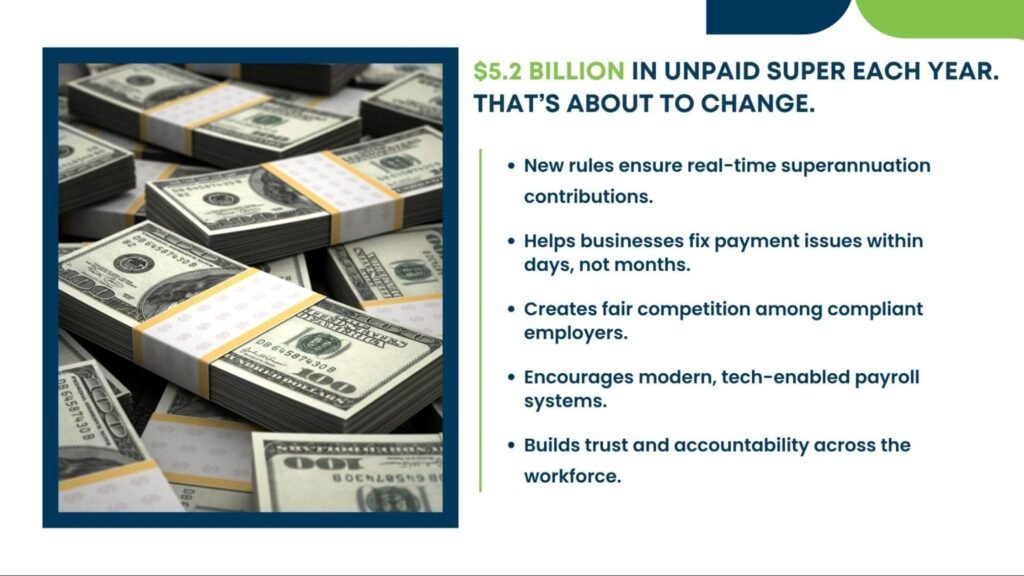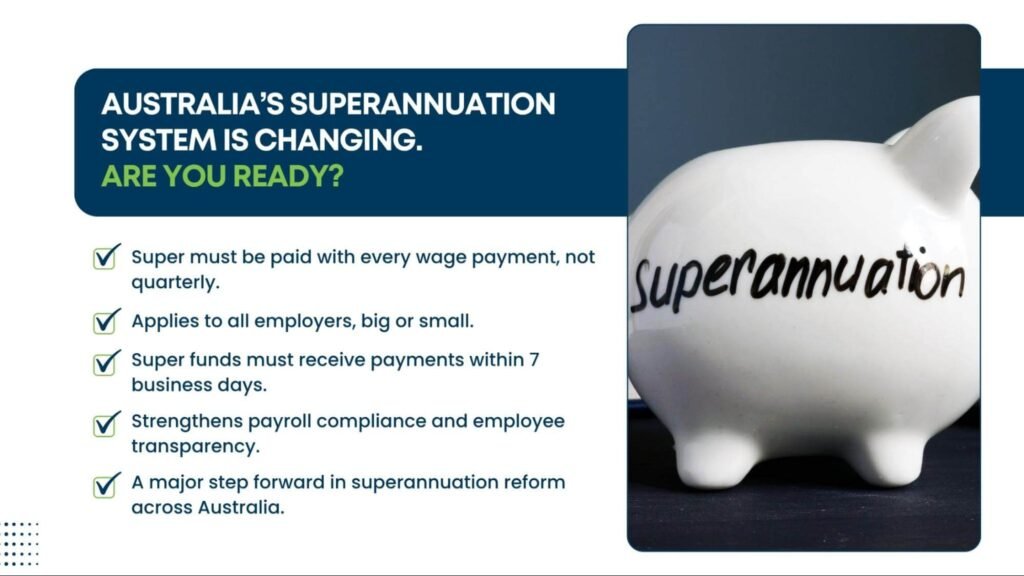The upcoming payday super reform for employers is set to reshape how businesses handle superannuation payments. The Federal Government has introduced new legislation that ties superannuation contributions directly to each pay cycle, a landmark superannuation reform that could replace the traditional quarterly payment model.
Introduced to Parliament on 9 October 2025, the bill is progressing quickly, signalling the government’s intent to strengthen payroll compliance and ensure employees receive their super in real time.
If passed, the Payday Super Changes 2026 will require employers to pay super at the same time as wages from 1 July 2026. For business owners, this shift presents both a compliance test and a chance to modernise systems, streamline reporting, and better meet their employer obligations.
While the super guarantee changes in 2026 will demand operational adjustments, they also open the door for more transparent, technology-enabled payroll processes that strengthen trust and accountability in the workplace.
Key Takeaways
- From 1 July 2026, Australian businesses must issue 30% of invoices electronically via the Peppol e-Invoicing standard.
- The ATO’s compliance focus will expand to include real-time digital record-keeping and e-invoicing adoption monitoring.
- GST, payroll, and BAS reporting will move toward increased automation and data pre-filling to reduce manual errors.
- Businesses that digitally transform early will benefit from smoother ATO integration, faster payments, and reduced compliance costs.
What’s Changing in 2026: New Compliance Rules
Under the Payday Super Reform for employers, several key updates will reshape how businesses manage superannuation contributions:
- Super must be paid with wages: Employers will be required to pay super at the same time they process payroll, whether that’s weekly, fortnightly, or monthly.
- Funds must reach accounts within 7 business days: Contributions must arrive in employees’ super funds within seven business days of payday, not just be lodged or processed.
- Applies to all employers: The super guarantee changes 2026 apply uniformly, whether your business employs two people or two hundred.
- Aligns with modern payroll compliance: Think of it as moving from quarterly instalments to real-time reporting, similar to PAYG withholding, only this time, it’s for super.
These Payday Super changes 2026 aim to strengthen employer obligations, reduce unpaid super risks, and improve payroll visibility across the economy. Businesses using outsourced payroll services can benefit from automated remittance features that simplify real-time super payments.

The Purpose Behind the Payday Super Reform
The payday super reform for employers is being introduced to address long-standing issues in Australia’s superannuation reform framework. Here’s why the change is happening:
- $5.2 billion in unpaid super each year: Treasury data shows that around $5.2 billion in superannuation contributions go unpaid annually across the economy.
- Causes of non-payment: These shortfalls often stem from cash flow challenges, administrative errors, or business distress, especially under the quarterly payment model.
- Visibility gap for employees: Under current rules, employees might work up to three months before discovering missed super payments, making problems harder to fix.
- Real-time transparency: With payday super changes 2026, contributions flow alongside wages, helping employers detect and resolve issues within days instead of months.
- Fair competition: The reform ensures that compliant businesses aren’t disadvantaged by competitors who delay payments, strengthening overall payroll compliance and employer obligations.
In short, these super guarantee changes 2026 aim to build a fairer, more transparent system that benefits both employers and employees while safeguarding Australia’s retirement savings.

2026 Compliance Changes: What Employers Need to Know
Here’s a point-wise summary of all key updates under the payday super reform for employers, effective 1 July 2026:
| Category | Key Change | Impact on Employers |
|---|---|---|
| Super Payment & Timing Rules | Super must be paid on payday | Employers must pay superannuation contributions at the same time as employee wages, ending the quarterly payment model. |
| Funds must reach super accounts within 7 calendar days | Payments must clear into employees’ super funds within seven days of payday, not just be processed. | |
| Applies to all employers | Whether you employ two people or two hundred, the Payday Super Changes 2026 apply equally across all businesses. | |
| Regulatory & Reporting Changes | ATO monitoring via Single Touch Payroll (STP) | The ATO will use real-time payroll data to detect missed or late payments faster, improving payroll compliance. |
| New definition of “qualifying earnings” | Clarifies what types of income count toward the Super Guarantee changes 2026, improving calculation accuracy. | |
| Retirement of Small Business Superannuation Clearing House (SBSCH) | From July 2026, small employers must use approved digital systems to make direct super payments. | |
| Penalty & Enforcement Updates | Stronger Superannuation Guarantee Charge (SGC) regime | Late or unpaid contributions may attract higher penalties and interest, reaching up to 60% in some cases. |
| Tighter voluntary disclosure rules | Employers who self-correct errors early may face reduced penalties compared to those identified through audits. | |
| Payroll & Cash Flow Implications | Integration with payroll systems | Employers must update payroll software to handle frequent super payments and ensure automation accuracy. |
| Impact on cash flow | Transitioning from quarterly to per-pay-run payments shortens cash cycles, businesses must plan for liquidity. | |
| Forecasting & budgeting adjustments | Firms should review cash flow models to align with the new payment frequency and maintain consistent financial health. |
Strategic Takeaway: Preparing Your Business for the 2026 Compliance Shift
The superannuation reform marks a major shift in employer obligations and payroll compliance. By preparing early, upgrading payroll systems, forecasting cash flow, and testing real-time payment, businesses can turn these super guarantee changes 2026 into an opportunity for greater transparency, efficiency, and trust.
How the Payday Super Reform Affects Business Cash Flow
The payday super reform for employers won’t change how much you pay, the superannuation guarantee rate remains at 11.5%, but it will significantly change when you pay it.
Under the new rules, payments must be made within days of payroll processing rather than months later. This shift demands better cash flow forecasting and financial planning. Businesses that use outsourced bookkeeping services or cloud-based accounting solutions can manage this transition more smoothly.
Here’s how to prepare for the payday super changes 2026:
- Review your current payroll process: If you already set aside super each pay run, you’re ahead of the curve.
- Plan for tighter cash cycles: Businesses that rely on the full quarterly window will need to realign cash flow planning and liquidity management.
- Start transitioning early: From January 2026, consider shifting to monthly or fortnightly payments. This six-month lead time allows you to test processes, assess cash flow impact, and fine-tune your systems before compliance becomes mandatory.
- Adopt automation: Integrate payroll with real-time payment and financial compliance outsourcing to reduce manual errors.
Ultimately, this superannuation reform is an opportunity to strengthen financial discipline. By embedding super payments into your regular payroll cycle now, you’ll make the transition smoother and future-proof your business operations.
Conclusion: Preparing for the 2026 Payday Super Era
The Payday Super Reform for Employers marks a defining moment in Australia’s payroll compliance landscape. From 1 July 2026, employers will need to move beyond quarterly payments and adopt real-time super contributions to meet new legal standards.
While the transition may initially challenge existing payroll processes, it also presents an opportunity to modernise systems, improve cash flow visibility, and strengthen employee trust.
Forward-thinking businesses that upgrade their payroll software, integrate STP-enabled systems, and review cash management cycles early will be best positioned to meet the reform head-on.
If your business needs guidance on aligning payroll processes or adopting automation for real-time compliance, contact our team today. By acting now, employers can turn compliance into a strategic advantage, ensuring accuracy, transparency, and long-term financial resilience in Australia’s new superannuation era.




